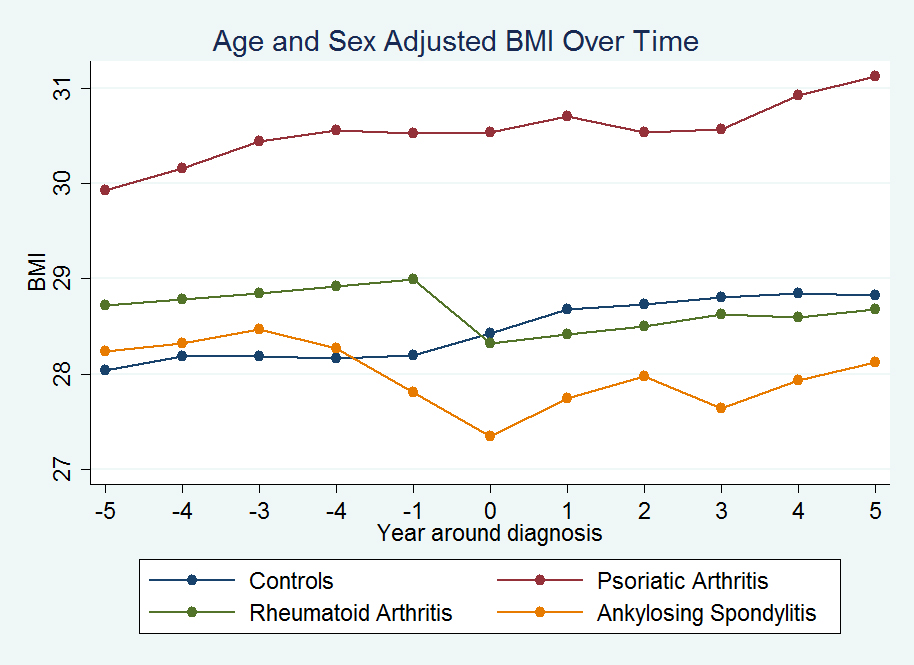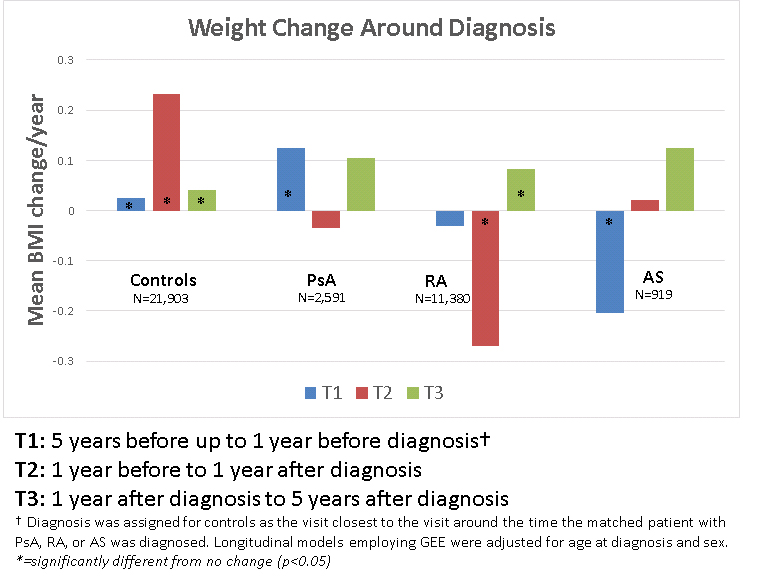Session Information
Session Type: ACR Poster Session C
Session Time: 9:00AM-11:00AM
Background/Purpose: Rheumatoid arthritis (RA) has been associated with weight loss around the time of diagnosis; little is known about weight change around diagnosis in psoriatic arthritis (PsA) and ankylosing spondylitis (AS). Furthermore, while obesity is a risk factor for RA and PsA, little is known about the importance of weight change as a disease risk factor. We examined weight change before, around, and after diagnosis compared to matched controls in a population-based cohort.
Methods: Data between 1994-2015 from The Health Improvement Network were used. Patients age 18-89 with incident PsA, RA, and AS and population controls matched on start date and general practice and with at least one body mass index (BMI) in each of intervals surrounding diagnosis were eligible. Change in BMI over time was examined using linear regression models incorporating generalized estimating equations with cubic splines with two knots (one year prior to diagnosis and one year after diagnosis) and adjusting for age and sex. Mean BMI over the 10-year study interval was plotted. We examined the significance of slope (compared to zero) at each interval (t1-t3) for each disease group and differences in slope for each interval in the disease groups compared to controls.
Results: Among patients with incident PsA, RA or AS, and matched controls, 2,591, 11,380, 919, and 21,903 respectively met the inclusion criteria. Among those included, the mean number of BMI measurements over 7.5 years of follow up was 8.5. Sex was 58%, 71%, 40%, and 62% female for patients with PsA, RA, AS, and controls respectively. The mean BMI at diagnosis was 29.8, 28.0, 27.6, and 27.9 respectively. Patients with PsA had the highest BMI in all time intervals (Figure 1) although the absolute difference in mean BMI was small. Controls gained a modest amount of weight over all intervals. Patients with PsA, RA, and AS had greater fluctuations in weight (Figure 2). Patients with PsA and RA lost weight around the time of diagnosis, but this was not statistically significant in PsA. Prior to diagnosis, patients with PsA gained weight at a higher rate than controls and patients with AS and RA lost weight at higher rates than controls. Patients with PsA and RA gained more weight after diagnosis than the other groups.
Conclusion: This population-based natural history study suggests that weight fluctuates around the diagnosis of inflammatory arthritis and in some cases these weight changes preceded the diagnosis by 5 years or more. Further studies to understand the importance of weight change as a risk factor for these diseases are needed.
To cite this abstract in AMA style:
Ogdie A, George MD, Gelfand J, Dubreuil M, Love T, Baker J. Weight Change before and after Diagnosis in Patients with Psoriatic Arthritis, Rheumatoid Arthritis, and Ankylosing Spondylitis [abstract]. Arthritis Rheumatol. 2017; 69 (suppl 10). https://acrabstracts.org/abstract/weight-change-before-and-after-diagnosis-in-patients-with-psoriatic-arthritis-rheumatoid-arthritis-and-ankylosing-spondylitis/. Accessed .« Back to 2017 ACR/ARHP Annual Meeting
ACR Meeting Abstracts - https://acrabstracts.org/abstract/weight-change-before-and-after-diagnosis-in-patients-with-psoriatic-arthritis-rheumatoid-arthritis-and-ankylosing-spondylitis/


